If you want to know about the types of concrete and its uses or wall cladding or types of footing, please click the link.
Infill walls are interior partitions that fill the gap between the exterior walls and the building structure. These walls are typically non-load bearing and are used to divide the interior space of a building into separate rooms or zones.
There are several materials that can be used for infill walls, including:
1) Infill wall
- The infill wall is the supported wall that closes the perimeter of a building constructed with a three dimensional framework structure
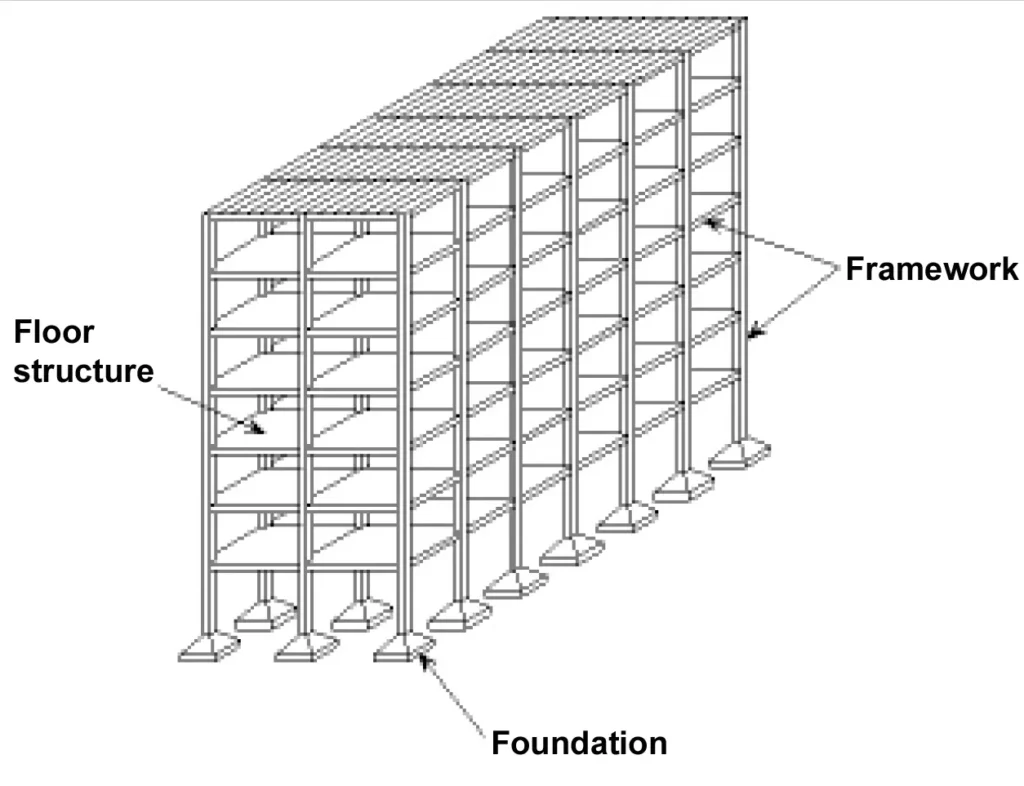
- Non – load bearing
- Resist wind loads applied to the facade
- Supports cladding

2) Infill wall material selection criteria
- Lightweight
- Fire resistance
- High durability
- Rigid
- Less maintenance
- Resistance to load ( wind load )
- Thermal comfort
- Acoustic comfort
- Water leakage
3) Burnt clay bricks
Burnt clay bricks can be used as an infill wall material. As a masonry material, they offer several benefits for use as an infill wall, including durability, fire resistance, and good thermal insulation properties.
When used as an infill wall, burnt clay bricks are typically laid between the exterior walls and the building structure. They provide a solid, fire-resistant barrier that can help to improve the overall safety and security of the building.
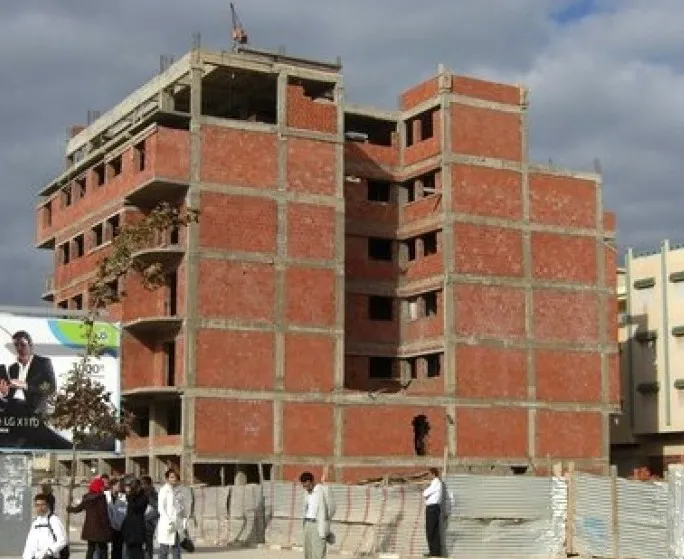
- Burnt clay bricks have been used for construction for thousands of years and are still widely used today, especially in areas with a long history of brickmaking.
- They are versatile, inexpensive, and widely available, making them a popular choice for construction projects of all sizes.
- In addition to their durability and fire resistance, burnt clay bricks also have good thermal insulation properties, which can help to reduce energy costs in buildings.
- They are also environmentally friendly, as they are made from natural materials and do not emit harmful chemicals.
3) Foam concrete or cellular lightweight concrete blocks
Foam concrete or cellular lightweight concrete (CLC) blocks can be used as an infill wall material. Foam concrete is a type of lightweight concrete that is made by mixing cement, sand, water, and a foam-producing agent. This creates a mixture with a lower density than traditional concrete, making it lighter and easier to handle.
CLC blocks are similar to foam concrete, but they are molded into blocks or panels that can be used as building materials. They are commonly used as an infill wall material due to their combination of light weight and high strength.
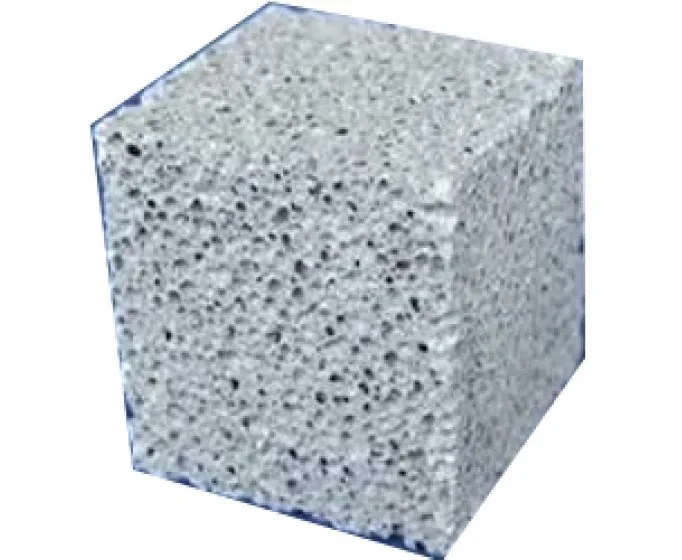
- Foamed concrete typically consists of a slurry of cement, fly ash or sand and water.
- This slurry is further mixed with a synthetic aerated foam in a concrete mixing plant.
- Foamed concrete mixture is then poured or pumped into moulds (this requires up to 24 hours to solidify).
When used as an infill wall, foam concrete or CLC blocks offer several benefits. They are relatively lightweight, making them easy to handle and install. They are also fire-resistant and have good thermal insulation properties, which can help to reduce energy costs in buildings.
Additionally, foam concrete or CLC blocks can be produced in a variety of shapes and sizes, allowing for a wide range of design options. They are also environmentally friendly, as they are made from natural materials and do not emit harmful chemicals.
However, one of the main drawbacks of using foam concrete or CLC blocks as an infill wall is their limited availability. They may not be readily available in all areas, and the cost of shipping them to a building site can be high.
Overall, foam concrete or CLC blocks can be a good choice for infill walls in certain circumstances, particularly in areas where weight and thermal insulation are important concerns. However, it is important to consider the specific requirements of the project and weigh the benefits and drawbacks of using foam concrete or CLC blocks before making a decision.
i) Advantages
- Weight reduction of superstructure using foam concrete walls: less steel reinforcements required for slabs, columns, beams and foundation due to lesser load.
- Earth quake resistant due to lesser weight of building
- Suitable for buildings in hurricane, cyclone and flood affected areas as the damage caused by foam concrete walls and roofs are minimal compared to conventional concrete based structures.
- Reduced cost of raw materials: By adding air, enclosed in foam bubbles, the volume of concrete can be increased at very low cost.
- Environmentally-friendly/Energy savings
- Faster construction using cast-in-situ application
- Improved thermal insulation: Foam concrete can achieve the same insulation results as normal concrete with only 20% of the weight and 10% of raw materials.
- Improved fire protection: A wall of 13 cm thickness and 1,250 kg/m³ can withstand a fire for 5 hours. A wall of 10 cm thickness and only 400 kg/m³ achieves the same result, due to the air enclosed in the cellular concrete.
- Easy to use/ produce/ handle
- Low investment: Just one simple machine required.
5) Hollow concrete block
Hollow concrete blocks can be used as an infill wall material. Hollow concrete blocks are made from a mixture of cement, sand, water, and aggregate, and they are molded into blocks with one or more hollow cavities. This makes them lighter and less dense than solid concrete blocks, making them easier to handle and install.
When used as an infill wall, hollow concrete blocks offer several benefits. They are relatively inexpensive and widely available, making them a popular choice for construction projects of all sizes. They are also durable and fire-resistant, providing a solid, fire-resistant barrier that can help to improve the overall safety and security of the building.
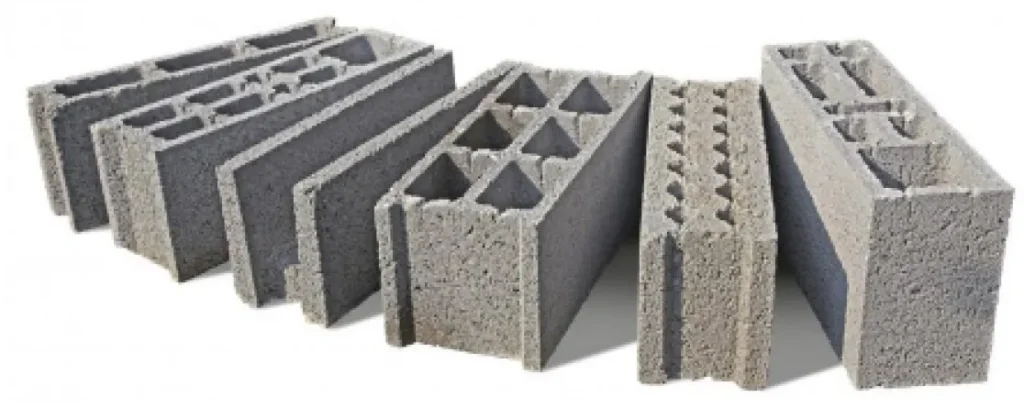
Hollow concrete blocks are precast masonry units made out of fly ash concrete mix with hollow cavities and are intended for use in the construction of both load bearing and non-load bearing wall structures.

- In addition to their durability and fire resistance, hollow concrete blocks also have good thermal insulation properties, which can help to reduce energy costs in buildings.
- They are also environmentally friendly, as they are made from natural materials and do not emit harmful chemicals.
- Overall, hollow concrete blocks can be a good choice for infill walls in certain circumstances, particularly in areas where fire resistance and durability are important concerns.
- However, it is important to consider the specific requirements of the project and weigh the benefits and drawbacks of using hollow concrete blocks before making a decision.
i) Advantages
- Highly Durable: The good concrete compacted by high pressure and vibration gives substantial strength to the block. Proper curing increase compressive strength of the blocks.
- Low Maintenance, Color and brilliance of masonry withstands outdoor elements.
- Load Bearing, strength can be specified as per the requirement.
- Fire Resistant
- Provide thermal and sound insulation: The air in hollow of the block, does not allow outside heat or cold in the house. So it keeps house cool in summer and warm in winter.
- Economical
- Environment Friendly, fly ash used as one of the raw materials.
8) Autoclaved aerated concrete block
Autoclaved aerated concrete (AAC) blocks can be used as an infill wall material. AAC blocks are made from a mixture of cement, sand, water, and aluminum powder. The aluminum powder reacts with the other ingredients during the manufacturing process, producing tiny pockets of air throughout the block. This makes AAC blocks lightweight and highly insulating, which makes them ideal for use as an infill wall.

- AAC material was developed in 1924 in Sweden.
- Cement + Sand + Lime + Water + Rising Agent = AAC
- SIZE : 600 X 200 X (75 to 300)
- Contains 60% to 85% Air by Volume.
- It has a porous structure
When used as an infill wall, AAC blocks offer several benefits. They are lightweight, making them easy to handle and install. They also have good thermal insulation properties, which can help to reduce energy costs in buildings.
Additionally, AAC blocks are fire-resistant, providing a solid, fire-resistant barrier that can help to improve the overall safety and security of the building.
Another advantage of using AAC blocks as an infill wall is that they can be easily cut and shaped to fit into tight spaces or around architectural features. This makes them a versatile material that can be used in a wide range of construction projects.
However, one of the main drawbacks of using AAC blocks as an infill wall is their cost. They are typically more expensive than other common infill wall materials, such as drywall or metal studs. Additionally, they may not be readily available in all areas, and the cost of shipping them to a building site can be high.
Overall, AAC blocks can be a good choice for infill walls in certain circumstances, particularly in areas where thermal insulation and fire resistance are important concerns. However, it is important to consider the specific requirements of the project and weigh the benefits and drawbacks of using AAC blocks before making a decision.
i) Properties
- Fire Resistance – Depending upon the thickness, AAC blocks offer fire resistence from 2 hours upto 6 hours.
- Pest Resistence – AAC blocks consist of inorganic material in its constitution, so helps preventing termites.
- Sound Proof – The porous structure of AAC blocks results into enhanced sound absorption.
- Earthquake resistant – The light weight property of the AAC blocks results into higher steadiness of the AAC blocks in the structure of the buildings.
- Faster Construction – AAC blocks come with larger sizes and fewer joints which results in faster construction work as the installation time is significantly reduced due to fewer amounts of blocks and the masonry amount involved is also lowered resulting into reduced time-to-finish.
- Long Lasting – Higher level of strength of these blocks gives
higher stability to the structure of the building. - Cost Saving
- Non-Toxic
- Thermal Insulation – The thermal conductivity of the AAC blocks helps maintaining the inner temperature to be warm during the winters and cool during the summers which ultimately leads to savings in air conditioning load and consequently enhanced energy efficiency.
- Moisture Resistance – AAC has a very porous structure which is characterized by “macro” pores. Macro pores are small air bubbles evenly distributed throughout the material. Therefore, absorption of water into the AAC material is minimal.
- Environment Friendly
- Lightweight
ii) Application

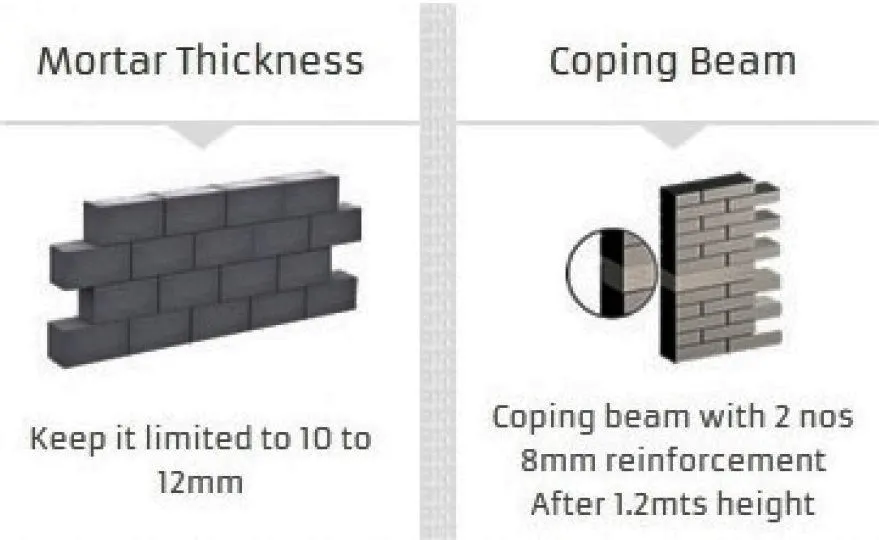

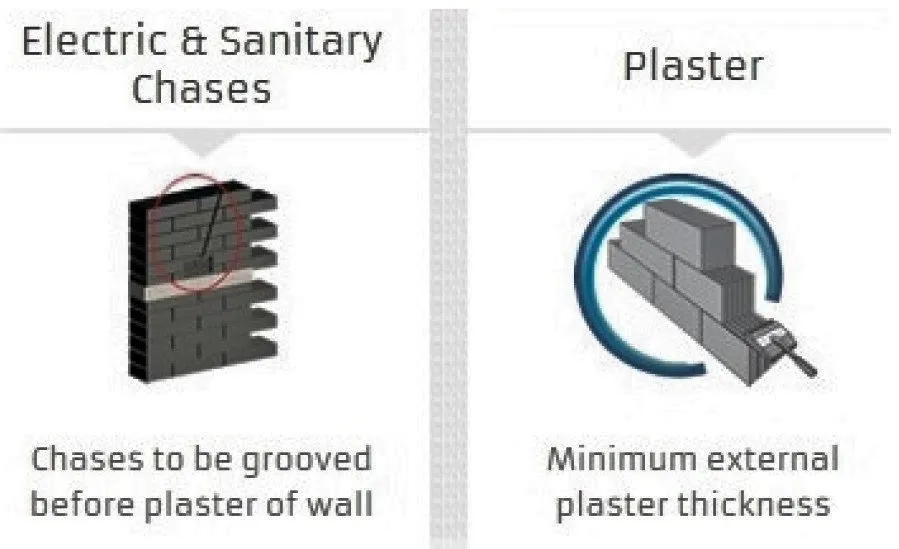
- The thickness of the external plaster should be 15 mm and internal plaster should be 10 mm.
6) Glass block
Glass blocks can be used as an infill wall material. Glass blocks are made from a solid piece of tempered glass that is molded into a block shape. They are commonly used in walls and partitions to provide light transmission while also maintaining privacy.

When used as an infill wall, glass blocks offer several benefits. They are durable and fire-resistant, providing a solid barrier that can help to improve the overall safety and security of the building.
Glass bricks provide visual obscuration while admitting Light. These can be used for both interior and exterior walls. These are available in different colours and sizes.
Additionally, glass blocks are transparent, which allows for natural light to enter the building and reduces the need for artificial lighting. This can help to reduce energy costs and improve the overall energy efficiency of the building.
Another advantage of using glass blocks as an infill wall is that they can be used to create unique and eye-catching designs. They are available in a variety of shapes, sizes, and colors, and can be used to create interesting patterns and designs.
However, one of the main drawbacks of using glass blocks as an infill wall is their cost. They are typically more expensive than other common infill wall materials, such as drywall or metal studs. Additionally, they may not be suitable for use in areas where privacy is a concern, as they provide limited privacy.
Overall, glass blocks can be a good choice for infill walls in certain circumstances, particularly in areas where natural light and unique design are important considerations. However, it is important to consider the specific requirements of the project and weigh the benefits and drawbacks of using glass blocks before making a decision.
i) Advantage
- Energy Conservation: Glass bricks are vacuum sealed, so they are considered highly energy conserving building materials.
- Weather Resistance: These are sturdy blocks which repel
different weather elements. They are highly thermal resistant too. - Attractive: Glass Bricks add to the aesthetic appeal of the place. There are different shapes, sizes, colours and surfaces available to meet personal choices.
- Light Transmission: Glass Bricks transmit 80% of light in both directions. Different textures and surfaces are available for control light transmission. They permit good amount of day light
- Safety: Since glass blocks are fire and sound resistant, they have an added safety feature. Moreover, they are difficult to break, hence better than conventional glass.
- Durable: Glass blocks are durable and scratch resistant too. Hence, the chances of damage when compared to conventional glass are lower.
- Cost Effective: Due to their durability and longer life cycle, these blocks require lower maintenance. Moreover, replacing the glass block is easier than replacing the entire glass plate.
The choice of infill wall material will depend on the specific requirements of the project, including the desired aesthetic, fire resistance, and soundproofing properties.